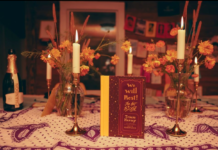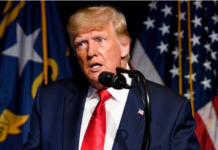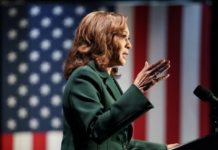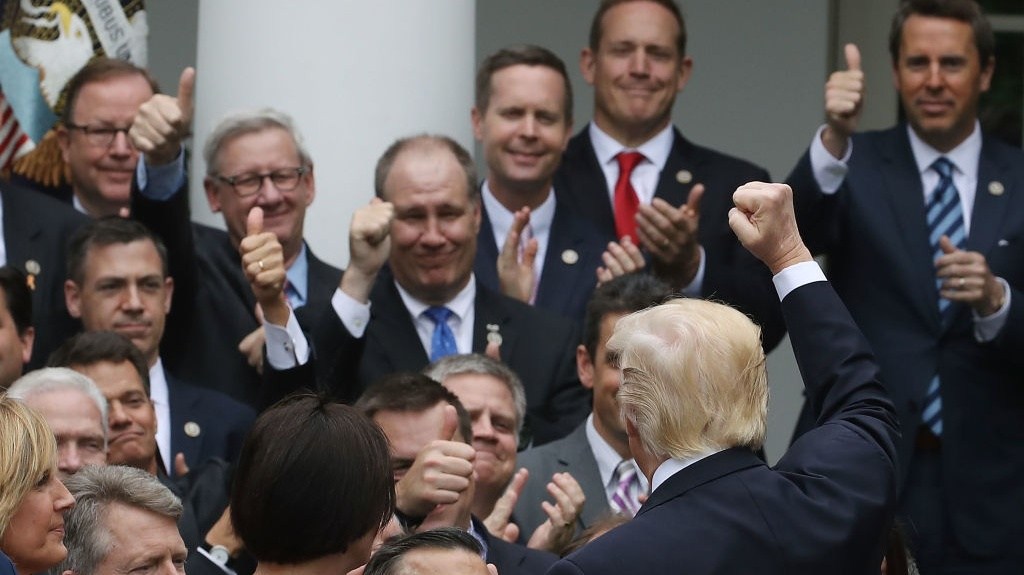By Nadra Nittle/Originally published by The 19th
For Natalie Fall, the Columbine High School mass shooting that left 13 dead and over 20 wounded was a formative moment. It was April 20, 1999, she was 10 years old, and she had never seen anything like the atrocity in Littleton, Colorado, which on Saturday marks its 25th anniversary.
“I remember it very, very vividly,” said Fall, executive director of March for Our Lives, a student-led gun control advocacy group. “Just like everybody else, I was gripped by this situation. It’s the first memory I really had of seeing any coverage like that or of having any understanding about the threat of mass gun violence.”
Fall, who grew up in neighboring Utah, didn’t know then that she would go on to become a leader in the gun control movement — she has also worked for the Giffords Law Center to Prevent Gun Violence — or that more than 400 school shootings would take place nationwide over the next 25 years. The names of some of those schools — Virginia Tech, Sandy Hook Elementary, Marjory Stoneman Douglas High, Robb Elementary — are widely known. The names of others have mostly been forgotten by the public because the shootings there weren’t massive enough to draw round-the-clock news coverage. But the students and teachers subjected to “everyday” gun violence suffer from trauma, too.
“We have an epidemic on our hands,” Fall said. “It’s killing kids. It’s disproportionately killing people of color, and it is just absolutely an urgent crisis.”
School shootings are now so commonplace that they have become a fixture in popular culture, inspiring plays, books, movies and songs. But the young people who have grown up with them, born years after the Columbine shooting, haven’t accepted gun violence as normal. Instead, they have rallied, voted and demanded change from lawmakers. Slowly, they have scored some wins, including pushing President Joe Biden to establish the Office of Gun Violence Prevention in September 2023.
“We’re grateful for that. We’ve certainly chalked up some hard-fought victories that I really believe have saved tens, if not hundreds, of thousands of lives in the years since Columbine,” Fall said. “So there’s reason to be hopeful, but our leaders are certainly not doing enough. The federal government just simply has to act, and the political climate at the moment makes that challenging.”
The 19th spoke with Fall about how gun control advocates are seeing progress at the state level, why gun violence is a gender issue and how mass shootings have mobilized “the lockdown generation” to hold elected officials accountable for change.
This interview has been edited for length and clarity.
Nadra Nittle: Have we as a nation progressed on gun violence over the past 25 years, or have we regressed, given the hundreds of mass school shootings that have taken place since Columbine?
Natalie Fall: Columbine really changed the way Americans think of modern-day school gun violence, and it really marked a shift in things. I certainly can’t lie and tell you that we’ve done everything that we need to do to address school violence. We don’t have to look far from Columbine to Sandy Hook to Parkland to Uvalde. It’s clear that gun violence is still ravaging our country and our schools. It’s become [a top] killer of young people, so it’s clear that the problem, unfortunately, has gotten worse. However, it’s important to look at what has been accomplished in that time and think about where we would be if those accomplishments hadn’t been won by the movement that we’re in.
What are some of those accomplishments?
Even just since Parkland [in 2018], we’ve passed over 300 gun safety laws at the state level — things like strengthening background checks. Lots of states have closed loopholes in the background check system while the federal government has refused. We’ve seen expansion of safe storage laws and restraining orders, and restrictions expanded around domestic abusers. We’ve also seen some really exciting growth and expansion in creative solutions or ones that were previously under-resourced but are highly effective. Those are things like community-based violence intervention programs that break the cycle of violence in communities that are most impacted by the issue. We’ve also seen a lot of new work being done to change the access to resources that victims have after they experience shootings or survive shootings or lose a loved one. So there’s been a lot of exciting movement, and, really, the story of success that can be told is at the state level. So we’re proud of that progress.
We’re also really proud that, in 2022, Congress passed for the first time in 30 years — and the president signed — a piece of gun safety legislation. It was hard fought. March for Our Lives and many other organizations and activists had spent years fighting for … anything we could get. Finally, after the shootings at Buffalo and Uvalde, after March for Our Lives held over 400 rallies in cities across the country, including D.C., we saw that bill get introduced and move through Congress. So that was very exciting.
There was also recent news that you’re excited about.
On April 11, actually, there was a huge announcement about the implementation of one aspect of the Bipartisan Safer Communities Act that will do everything that the Biden administration can do without Congress to close loopholes in the background check system. Some estimates suggest that this new rule will make it so that an additional 23,000 sellers will be forced to go through background checks when selling guns.
Also, one piece of legislation that we’re really getting behind and really eager to see pass is called the Counseling Not Criminalization Act, which was introduced by Rep. Ayanna Pressley and Sen. Chris Murphy. It is a bill that would put $5 billion into resources like counselors, social workers and other things like that in schools rather than adding more armed police officers, which we know is just part of the school-to-prison pipeline that makes young people of color less safe in their schools, not more. Nevermind that it doesn’t do anything to deter threats of school violence.
Some advocates say that gun control is an issue that overlaps with gender justice. What link do you see between the two?
Women are five times more likely to die by gun violence if there is a gun in the home. There’s all kinds of disturbing statistics to look at on guns and domestic violence and how that impacts women and girls. I think that there’s been some progress made around domestic violence restraining orders and protecting women from abusers, not just if they are their spouse but if they’re any kind of intimate partner. Some expansion of restrictions have been good, but there’s a lot more to do, and we have to think about this as a women’s issue as much as anything else.
There’s also the online radicalization of young men, in particular, that leads to domestic violence and mass violence. We have to look at all kinds of things, like how has technology and social media contributed to that and what can we do to crack down on it from that angle? Culturally, what has changed in the last few decades that has brought us to this point where we have men who are being radicalized into violent extremism online, and how does that map against increasing gun sales and gun injury and death rates?
A generation of young people have grown up since Columbine. How has gun violence affected them not only on a political level but also on an emotional one?
March for Our Lives is an organization founded by and for young people and survivors. When we talk about the crisis and threat of gun violence, we’re speaking from experience. We’re the lockdown generation. We’ve spent our childhoods and our early adolescence ducking under desks and going to loved ones’ funerals. So this is not theoretical to us. It’s a lived experience. So you’ve got a whole generation of young people who haven’t known a life without the threat of gun violence in their schools, in their communities, in their movie theaters, you name it. So that takes a tremendous emotional and mental toll on a generation of people. It’s no surprise that we have a mental health crisis amongst young folks as well. There’s just this sort of immeasurable trauma that one has to live with, so our children are certainly bearing the brunt of this crisis.
It certainly is also something that has mobilized young people in an unprecedented way. In 2018, millions of people marched across the world to support March for Our Lives and call for change. Gun violence prevention advocacy really was a political entry point for a lot of young people and first-time voters. They went on to break records in the 2018 midterms with the highest youth turnout in a midterm in history, by most measures, and we’ve just continued to see record and extremely high youth turnout in every cycle since then. We selected gun safety champions up and down the ballot in 2020. Young people have been defying expectations, really proving over and over again that they are a political force to be reckoned with, and they are an emerging and growing one.
We’re really excited to see Gen Z stepping into their political power and even into office themselves. The first-ever Gen Z congressman, Rep. Maxwell Frost [of Florida], is a former staff member here at March for Our Lives.
Twenty-five years ago few people would have predicted that some policymakers and media personalities would vilify gun violence victims and their families. What are your thoughts on this turn of events?
We know that dynamic very, very well. The Parkland students were pretty relentlessly harassed, especially some of the most vocal survivors who led the movement and the march in those early days. The threats to not only the students but their families have continued over the years. Even today, when we do events at state capitols, sometimes we see armed protesters, so gun violence is often a rather frightening issue to work on when you’re doing so very publicly. The gun lobby has spent decades marketing misinformation to our communities, and I believe that has been the No. 1 contributor to these kinds of violent threats and mockery of survivors and parents of victims. I think it’s a sign of a larger progression of extremism around a lot of issues in our politics and society. Lawmakers are willing to ban books before they’re willing to ban, or even restrict, assault weapons in any way. So, I think it’s part of a broader cultural moment that threatens safety and threatens rights in a lot of different areas.
The gun lobby uses racist and misogynistic marketing practices to stoke fear amongst Americans, to tell them that the government is coming for their guns, and, therefore, they must stock up. They have successfully pushed the ‘guns everywhere’ agenda. After Sandy Hook, it took a really, really ugly turn in terms of the kind of harassment that victims and families received.
For many students in under-resourced communities, gun violence is a routine part of their lives. But since the shootings they experience typically aren’t mass shootings, their trauma does not command the same kind of news coverage that extreme acts of indiscriminate gun violence do. Does this concern you?
Rightfully, there’s a lot of criticism of the media and the mainstream gun violence prevention movement historically, at least, about what kinds of shootings get attention. I think there’s no denying that historically and over the years, White and wealthy communities that experience shootings receive the most coverage. They become highly sensationalized. Also, those communities tend to get lots and lots of resources pumped into them in the days after those incidents, which they absolutely should continue to get, but we need to have that for every community. Why is it that when a community experiences a natural disaster, they receive support from the federal government, but when a community experiences a mass shooting, they don’t receive similar kinds of support from the federal government?
I also think that, yes, we need way more coverage of everyday gun violence. We need more coverage of what gun suicide looks like in communities, who it impacts, and the threat that having a firearm in your home poses. We need way more coverage of the impact on Black and Brown communities of gun violence, of illegal trafficking of guns, and guns flooding communities already struggling with economic issues. We absolutely need more coverage of things that fall outside of that narrow definition of a mass shooting. We have to cover the rest of these things with just as much urgency, with just as much care as we do those more highly publicized ones.



































